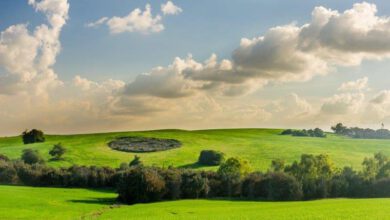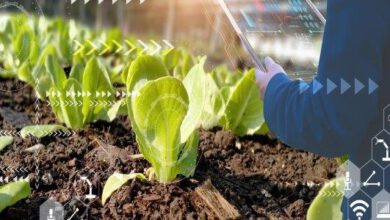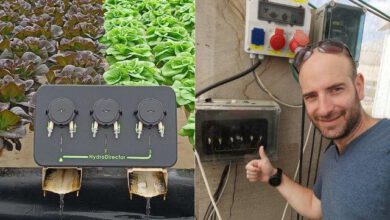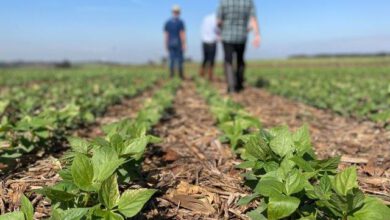Chemical thinning influence on ‘Golden Delicious’ apples Fruit number in Israel
Omer Crane , Omerc@migal.org.il , Ayelet Sar Shalom, Yuval Ogny Northern R&D MIGAL, Galilee Technology Center
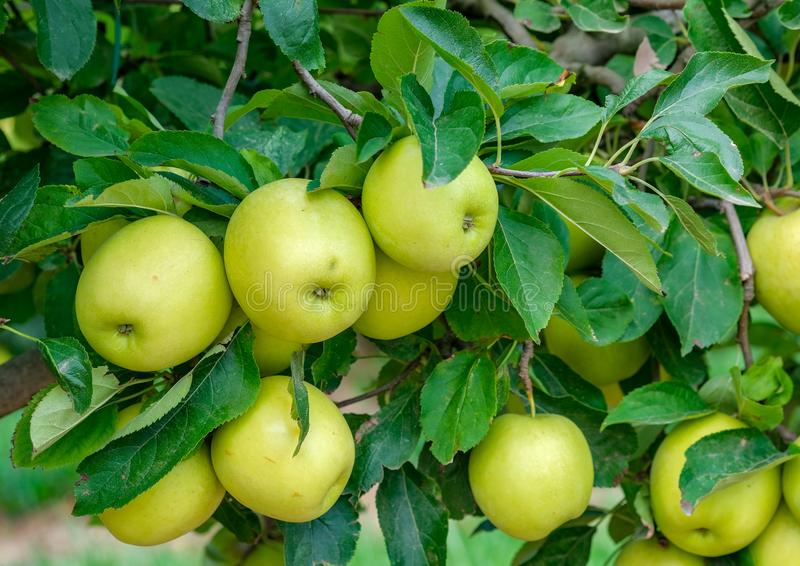
.jpg)
Introduction:
Fruit thinning is a common agricultural practice in apple (Malus X domestica) orchards, necessary to ensure profit. When too many flowers per tree set fruit, small fruits with poor quality will be picked in the first year and too little in the next due to alternate bearing (Wertheim 1999; Haberman et al., 2016). Thinning of fruits during the early stages of growth will overcome these two phenomena and will ensure high quality fruits in all years.
In Israel, the common practice for chemical thinning is 2 applications during the first 21 days after full bloom. The first application is between 3 to 7 days after full bloom with synthetic auxin (mostly 0.4% Agritone which combines both Naphthaleneacetic acid (NAA) and 1-Naphthaleneacetamide(NAD)). The second application is 14 – 21 days after full bloom with either synthetic auxin (NAA 0.1% Alfanol Super or NAD 60 ppm Dilamide) or synthetic cytokinin (100 ppm 6-Benzylaminopurine (BA)) (Stern et al., 2011 a&b) or metamitron (Brevis).
Although early thinning, 2 – 4 weeks after full bloom, was found to be beneficial for fruit size and return bloom (Stern et al., 2008), uncertainty in chemical intensity, bring farmers to minimize the use of chemical thinning and to rely on hand thinning after ensuring that fruit set is adequate (Wertheim 1999). This practice is expensive and often is done later in the season after alternate bearing and fruit size are set.
The objective of the current research was to characterize the influence of the first Agritone chemical thinning on individual trees, in order to improve its accuracy.

Fig 1 – Percentage of persisting fruit in control and Agriton thinned trees.
5 trees from each treatment and 50 inflorescences on each tree were marked at full bloom. At the end of June after natural fruit drop the number of persisting fruits in each inflorescence was counted. Percentage of persisting fruits was calculated for each tree and the graph represent average for all trees in each treatment. Bars represent standard error (SE). Gray bars are control trees and black Agriton treated trees. In all years 0.4% Agriton was applied 3 – 7 days after estimated full bloom.
Materials and methods: Experiments were conducted during 2012 – 2020. Trees were trained with standard horticultural practices, in a commercial apple orchard at the ‘Matityahu’ research station of the Agricultural Research Organization (ARO), in Northern Israel (3380400400 N, 3582700400 E, altitude 667 m). Trees in the experiment are from the cultivar ‘Golden Delicious’, grafted on M9 rootstock (Malus _ domestica ‘Golden Delicious/M9’), planted in 1997. Trees were graded according to their intensity of flowering, from 0 (not flowering) to 5 (high flowering) and were chemically thinned according to an experimental protocol. Trees were not hand thinned. In each tree 50 inflorescences were marked by ribbons. At the end of June, the number of fruits on each inflorescence was counted and at harvest. total weight and fruit number data were collected for each tree.

Fig 2 – Percentage of persisting fruit in trees at different flowering intensity.
5 trees from each flower intensity (2 – low flowering, 3 – mild flowering and 4 – high flowering) were marked at full bloom and Percentage of persisting fruits was calculated as mentioned in Fig 1. Average represent all flower intensity trees. All trees were thinned by Agriton.
Results and discussion:
In order to characterize the influence of Agritone chemical thinning on individual trees. we have defined its influence on percentage of persisting fruits (Fig 1). Percentage of persistent fruits in control (untreated) trees was 31% to 17% depending on the year. In the treated trees, percentage of persistent fruits was 9% to 20%. The data emphasizes the problem of uncertainty in chemical thinning. In order to define flower intensity (number of flowers on the tree) on thinning reaction to Agritone treatment. we have divided trees according to their intensity of flowering (see ‘Materials and methods’). Percentage of persistent fruits did not differ between flower intensity (Fig 2) indicating a mechanism of thinning that is not related to the number of flowers on the tree. We have evaluated inflorescence intensity as representing inflorescence number and determined its effect on final fruit number at harvest after chemical thinning (Fig 3).

Fig 3 – Correlation between inflorescence intensity and fruits per tree:
Trees treated with 0.4% Agriton were harvested. Trees were harvest separately and fruit number per tree was calculated by dividing the Wight of 100 fruits collected from each tree. Graph represents correlation between inflorescence intensity 0 (not flowering) to 5 (strongly flowering) and fruit number per tree at harvest.. Straight line equation and R2 ratio are indicated.
A significant correlation (R2>0.5) between inflorescence intensity and fruit load at harvest was found. In 2020 we applied different thinning treatments at 4 levels of intensity (Fig 4). Trees were divided according to flower intensity. It was found that in low flowering trees. the fruit number at harvest was low (we aimed at 500 fruits per tree) and the number was influenced by thinning intensity. At mild flowering trees, the fruit number was high in the low, mild and strong thinning. In the very strong thinning treatment, the fruit number was 550, which is more or less the desired fruit number. In the high flowering trees all thinning treatments were not good and fruit number was too high. It can be concluded that thinning according to flower intensity can be a powerful tool to avoid over thinning in low flowering trees and to reach the desired fruit number in mild flowering trees. In high flowering trees the acceptable thinning treatment in Israel is not strong enough and different thinning protocols should be found.

Fig 4 – fruit number at harvest in trees at different flowering intensity treated with 4 thinning protocols.
5 trees from 3 flower intensity treat with 4 different thinning protocols were Harvested. Fruits were counted in each tree. average and SE were calculated as in Fig 1. weak thinning (1 liter per tree of 0.4% Agriton 3 days after full bloom and 2 grams Brevis at 14 days after full bloom). Mild thinning (1 liter per tree of 0.4% Agriton 3 days after full bloom and 4 grams Brevis at 14 days after full bloom), Strong thinning (1.5 liter per tree of 0.4% Agriton 3 days after full bloom and 2 grams Brevis at 14 days after full bloom) Very strong thinning (1.5 liter per tree of 0.4% Agriton 3 days after full bloom and 4 grams Brevis at 14 days after full bloom
Conclusion:
In the current research it was found that in ‘Golden Delicious’, the percentage of persisting fruits is not influenced by flower number. Therefore, a thinning protocol should be used according to flower intensity. Currently, there are few companies that work on precision thinning by analyzing picture and building a GPS map that is used to guide a precision sprayer. One of them is AgriWare, a company that works in the north of Israel. In the near future we intend to develop a thinning protocol applicable for high flowering trees and to build a model to predict natural and Agritone fruit drop according to environmental conditions. This model will be integrated into a Decision SupportSystem (DSS) that will use cameras and automatic sprayer to help farmers achieve high quality fruits.
Acknowledgements
This research was supported by the Chief Scientist Ministry of Agriculture and Rural Development, Israel (Grant # 458-0576-12).
*The MIGAL Galilee Research Institute Ltd
References:
Wertheim, S. J. “Developments in the chemical thinning of apple and pear.” Plant Growth Regulation 31.1-2 (2000): 85-100.
Haberman, A., Ackerman, M., Crane, O., Kelner, J. J., Costes, E., & Samach, “ADifferent flowering response to various fruit loads in apple cultivars correlates with degree of transcript reaccumulation of a TFL1‐encoding gene.” The Plant Journal (2016).
Stern R,A., Agiv M., OgniY. Influence of thinning time and intensity on fruit size and distribution in ‘Royal gala’ apple. Alon Hanotea’ vol. 62 August-September (2008).
Stern R,A., Agiv M., Ogni Y., Doron I “Chemical thinning in ‘Golden Delicious’ apple to increase fruit size”. ‘Alon Hanotea’ vol. 65 (2011a).
Stern R,A., Agiv M., Ogni Y., Doron I., Meiri A “Chemical thinning in ‘Red Delicious’ apple to increase fruit size and to avoid alternate bearing ” ‘Alon Hanotea’ vol. 65 (2011b).

